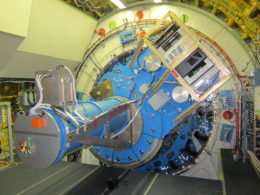In December, AAS Nova Editor Susanna Kohler had the opportunity to fly aboard the NASA/DLR Stratospheric Observatory for Infrared Astronomy (SOFIA). This week we’re taking a look at that flight, as well as some of the recent science the observatory produced and published in an ApJ Letters Focus Issue.
One of SOFIA’s great strengths is that the instruments mounted on this flying telescope can be easily swapped out, allowing for a broad range of infrared observations. Three of SOFIA’s instruments are featured in science recently published in the ApJ Letters Focus Issue: the Far Infrared Field-Imaging Line Spectrometer (FIFI-LS), the High-Resolution Airborne Wideband Camera Plus (HAWC+), and the Echelon-Cross-Echelle Spectrograph (EXES).
Meet EXES
EXES is used for high-resolution spectroscopy at mid-infrared wavelengths — from 4.5 to 28.3 µm — to study molecular gas in dense, quiescent clouds and protostellar disks. EXES uses a special coarsely-ruled aluminum reflection grating to spread light into a spectrum, allowing scientists to identify specific spectral lines associated with emission from different molecules.
The instrument’s high spectral resolution enables the study of molecular hydrogen, water vapor, and methane from sources like molecular clouds, protoplanetary disks, interstellar shocks, circumstellar shells, and planetary atmospheres. For many sources, EXES is able to achieve comparable sensitivity even to space-based observatories like Spitzer.
Some Recent EXES Science

Image from the Subaru telescope showing the location of the Becklin-Neugebauer object in Orion. [NAOJ/Subaru Telescope]
If true, we could expect that the Becklin-Neugebauer object might have dragged some of the hot, dense molecular gas along with it when it was ejected. A team of scientists led by Nick Indriolo (Space Telescope Science Institute) used EXES to search for signs of hot water molecules moving along with the Becklin-Neugebauer object, and came up empty-handed — adding one more perplexing clue to the mystery of this strange source.
••••••
Hot molecular cores are compact regions of dense gas that represent an intermediary stage of massive star formation; once a protostar forms in a collapsing cloud, it heats its surroundings and drives an outflow of evaporating material.
A study led by Andrew Barr (Leiden University, the Netherlands) explores the composition of the hot molecular core AFGL 2591 using EXES infrared observations. The authors detect carbon monosulfide (CS), a molecule that can be used to probe the physical conditions deep in the innermost parts of the hot core near the base of the outflow.
••••••

Hubble image of a nearby Young Stellar Object, V1331Cyg. [ESA/NASA/Hubble/K. Stapelfeldt/B. Stecklum/A. Choudhary]
••••••
Does Jupiter’s moon Europa host plumes of water erupting from its surface? So suggest Hubble images from 2012 and recently re-analyzed data from NASA’s Galileo spacecraft. To test this theory, a team led by William Sparks (SETI Institute and Space Telescope Science Institute) used SOFIA/EXES to search for direct evidence of the presence of water vapor erupting from Europa’s surface.

Composite image of Europa from Galileo and Voyager, superimposed on Hubble data that suggests the presence of plumes of water vapor at roughly the 7 o’clock position off Europa’s limb. [NASA/ESA/W. Sparks (STScI)/USGS Astrogeology Science Center]
Citation
ApJL Focus issue:
Focus on New Results from SOFIA
EXES articles:
“High Spectral Resolution Observations toward Orion BN at 6 μm: No Evidence for Hot Water,” Nick Indriolo et al. 2018 ApJL 865 L18. doi:10.3847/2041-8213/aae1ff
“Infrared Detection of Abundant CS in the Hot Core AFGL 2591 at High Spectral Resolution with SOFIA/EXES ,” Andrew G. Barr et al. 2018 ApJL 868 L2. doi:10.3847/2041-8213/aaeb23
“High-resolution SOFIA/EXES Spectroscopy of SO2 Gas in the Massive Young Stellar Object MonR2 IRS3: Implications for the Sulfur Budget,” Ryan Dungee et al. 2018 ApJL 868 L10. doi:10.3847/2041-8213/aaeda9
“A Search for Water Vapor Plumes on Europa using SOFIA,” W. B. Sparks et al. 2019 ApJL 871 L5. doi:10.3847/2041-8213/aafb0a

